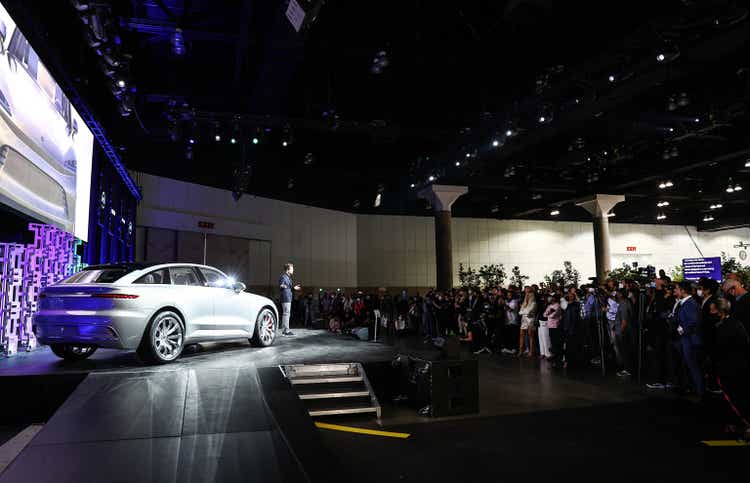Summary:
- Mullen’s cash and equivalents are insufficient against its current cash burn from operations.
- The company does not have the liquidity required to start the production and deliveries of its flagship SUV.
- Recent acquisitions offer will ramp short-to-medium-term cash burn.
Mario Tama
Mullen Automotive (NASDAQ:MULN) might never be able to bring its vehicles to market with cash and equivalents at $61 million against cash burn from operations of $18.3 million last quarter. This comes as the recent public company chases an aggressive strategy of growth with two back-to-back acquisitions set against an ambitious roadmap to bring its premium sport utility EV, the Mullen FIVE, to market. The $55,000 vehicle wants to enter a crowded space currently dominated by Tesla (TSLA). The jostle for market share will also include other significantly better-capitalized competitors from upstart Rivian (RIVN) to traditional automaker Volkswagen (OTCPK:VWAGY).
To be clear here, there will be very little space for undercapitalized EV companies trading below the $1 minimum NASDAQ listing requirement and with questionable acquisitions set against a cycle of cash burn. Mullen recently stumped up $105 million to acquire the assets of EV company Electric Last Mile Solutions, which filed Chapter 7 bankruptcy in June of this year. The acquisition was see Brea, California-based Mullen take on Electric Last Mile’s intellectual property, inventory, and manufacturing plant. Mullen’s rationale for the acquisition is based on Electric Last Mile’s Indiana plant, which is capable of producing 50,000 vehicles annually. This will see Mullen establish a production platform for the Mullen FIVE and its Class 1 and Class 3 commercial delivery vehicles. It also builds on the company’s $148.2 million acquisition of a controlling stake in EV truck manufacturer Bollinger Motors. Management stated the Indiana facility will allow them to speed up the development of Bollinger’s B1 SUV and B2 pickup truck.
On the back of the Electric Last Mile buyout, Mullen expects to start Class 1 and Class 2 commercial EV production in 2023. This is around 12 months faster than their initial guidance as the Mullen FIVE is set for production in 2024.
Cash Burn, Dilution, And A Cycle Of Destruction
How did a company with cash of $61 million for its last reported fiscal 2022 third quarter ending June 30 have the liquidity to buy two companies for a combined total of $253.2 million? Indeed, Mullen’s management described the Electric Last Mile buyout as an “all-cash transaction” in the press release announcing the closing of the deal. The all-cash component likely describes an equity offering for that amount, with proceeds paid to Electric Last Mile’s creditors.
The company’s recently filed a definitive proxy statement with the SEC for shareholders to vote on the 23rd of December for the approval of an increase in the aggregate number of authorized shares of common stock from 1.75 billion to 5 billion. Mullen is also asking shareholders to approve an up to 1-for-25 reverse stock split and an amendment to facilitate the issuance of $150 million in convertible notes and up to $190 million in convertible preferred stock. Mullen’s inherently substantial growth is being built on the material dilution of its shareholders, with the convertible note issuance alone being 42% of its current market cap of $360 million.
The company’s cumulative cash burn from operations for its current fiscal year is at $43.2 million, with this set to increase with the inclusion of further pre-revenue entities. Mullen is doing more too, announcing a partnership to equip its EVs with technology to enable the creation of drinking water from the air.
A Matter Of When, Not If
Against a crowded EV space, this initiative is seemingly commendable. However, to bears, it becomes a liability when aggregated with the broader operational story of an eight-vehicle production lineup from three fundamentally different companies. These companies all had different production stacks up until a few months ago, one of them recently went bankrupt, and all of them are still losing money. Bringing a new car to market needs hundreds of millions of dollars in consistent capital, and Mullen is embarking on taking a campaign of more.
The company needs liquidity to now ramp up production of two SUVs, one pickup truck, and a plethora of commercial vehicles from a Class 1 commercial van, a Class 3 medium-duty vehicle, Bollinger’s B4 chassis cab, the small-sized Mullen I-GO, and the DragonFLY high-performance sports car.
Rivian has around $13.2 billion in cash and equivalents and is looking to bring three vehicles to market. Lucid Motors (LCID) with around $3.3 billion is looking to bring two vehicles to market. Fundamentally, an investment in Mullen is a bet that the company can materially dilute its way to alpha. Current liquidity is simply not enough to bring the majority of its product lineup to market, a situation compounded by the low stock price and the market risk-off sentiment that has collapsed the valuation of once high-flying EV companies. Mullen is not a buy for anyone at this time, with the dilution of shareholders and operational cash burn likely to remain the dominant part of the company’s story for the quarters ahead.
Disclosure: I/we have no stock, option or similar derivative position in any of the companies mentioned, and no plans to initiate any such positions within the next 72 hours. I wrote this article myself, and it expresses my own opinions. I am not receiving compensation for it (other than from Seeking Alpha). I have no business relationship with any company whose stock is mentioned in this article.
